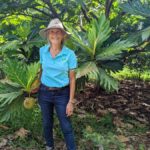The plant amaranth is native to Central America, but with permission from a collective of Maya Achi farmers in Guatemala, its seeds are being sown in the U.S., including at Stone Bend Farm near Ithaca, New York. “As we look at climate change, it’s a plant that’s so healthy, and that can adapt to so many different places and conditions,” says Sarah Montgomery, co-founder of Qachuu Aloom Mother Earth Association, who hosts events (like this one, above) to share ancestral knowledge of how amaranth is grown. Not only is amaranth a highly nutritious protein, it “holds the story inside of it of the disconnection and the genocide of people,” Montgomery says, as it was nearly wiped out during colonization times in the early 1500s. Today, the plant is making a comeback and may be useful as the planet warms, as it adapts to different growing conditions. The solution to climate change is “within nature,” Montgomery says. “We just need to learn how to listen.”
Harvesting Amaranth, a Superfood of Indigenous Agriculture
The farming collective Qachuu Aloom shares ancestral knowledge of growing this ancient grain, a climate-resilient crop.
In this video, the practices of indigenous agriculture are shared through the collecting of amaranth seeds. (Video credit: Sue Williams)


